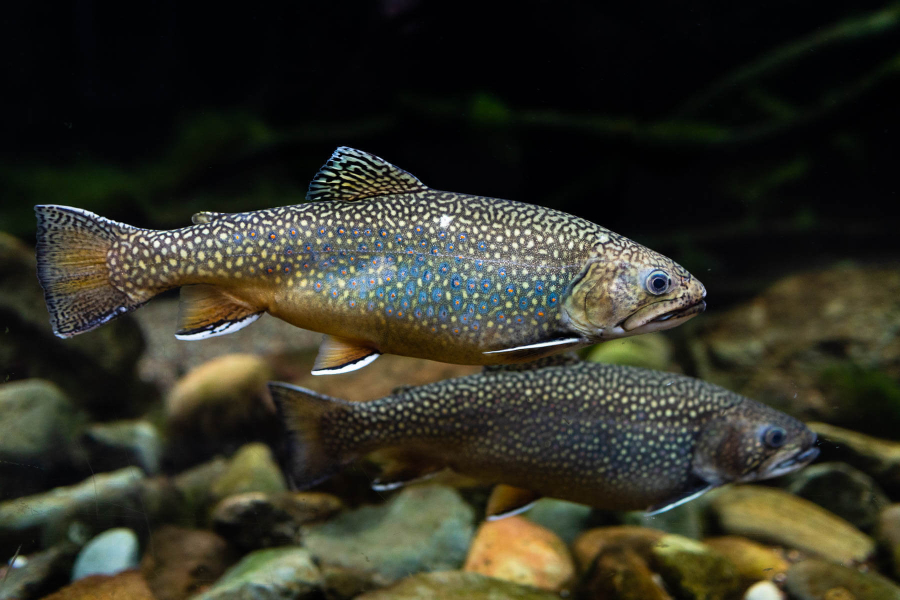Who lives here? Tracking species by the DNA they leave behind

Humans lose, on average, 30,000-40,000 skin cells every hour. As we move through the world, we shed those skin cells and leave a trail of genetic information in our wake. Each of those cells contain the building blocks of our genetic code— up to six feet of DNA per cell. Researchers are starting to use this newly discovered information for a variety of ecological applications, as humans aren’t the only ones with a genetic code! Every organism leaves a trail of DNA in the blood, waste products or skin it leaves behind.
When this genetic information is collected from the environment—for example, found in a water or soil sample rather than directly from the host—it is called environmental DNA, or eDNA. As scientists analyze the sample and the DNA it contains, they look for genetic markers: specific series of nucleotides that allow scientists to identify the source species. Genetic markers work similarly to an area code on a phone number. A “410-” area code means that you live in the Annapolis, Maryland area; having the sequence “AAGA” at a specific marker in your DNA might mean that you are a brook trout. Utilizing these genetic markers from eDNA, scientists can determine which species were in that environment recently.
Scientists tracking an animal can analyze many samples throughout an area while looking for a specific species. Other times, scientists want an overall picture of the community, so they analyze the eDNA from a few samples and document all the species present. Both methods considerably cut down on the cost and effort associated with repeated sampling. Having to physically scour every inch of a stream to get a comprehensive sense of community is intensive, and often doesn’t yield productive results. Taking a few water samples from a stream is more efficient and, often, much cheaper.
Through a collaboration between Smithsonian Environmental Research Center (SERC) and the University of Maryland Center for Environmental Science (UMCES), eDNA is being applied in the hunt for two important prey species in Chesapeake rivers: alewife and blueback herring. Both are migratory fish, spending most of their lifecycle in open water and only returning to their native streams to spawn. Both species are in steep decline from pollution, overfishing and dams that block their routes. In order to help protect these fish, we must know the location of their spawning grounds—and that’s where eDNA comes in.
Matt Ogburn (SERC) and Louis Plough (UMCES), the biologists leading this effort, collected nearly 500 water samples from 196 sites throughout the Chesapeake Bay watershed. Using eDNA, they tested for the presence of alewife and blueback herring in each sample and were able to get a picture of their habitat use over a very large area, a feat that could not realistically be accomplished with traditional sampling methods.
eDNA has other applications as well. The key to preventing the spread of invasive species is early detection. The longer it takes for you to notice them, the larger the invasive species population can grow. Over the past few years, the Mid-Atlantic Panel on Aquatic Invasive Species has funded a variety of projects looking to use eDNA: from tracking invasive snails, to detecting infectious pathogens in frogs, to monitoring single celled organisms called diatoms. In New York, Cornell University operated a citizen science program where they sent eDNA kits to school groups and had them sample streams for the invasive round goby. This program not only confirmed the presence of the round goby in ponds where it was suspected, but also detected this little fish in part of the Finger Lakes region where it had never been documented.
The quick and easy nature of eDNA has opened new non-traditional partnerships and methodologies to scientists. Whether you are looking for a rare native species that you need to protect or are hoping to stop an invasion before it happens, eDNA sampling is quickly becoming a go-to method for researchers in our watershed and beyond.

Comments
Informative, I believe collecting the eDNA beats shocking the stream to see which fish float to the top.
Thank you!
Your comment has been received. Before it can be published, the comment will be reviewed by our team to ensure it adheres with our rules of engagement.
Back to recent stories